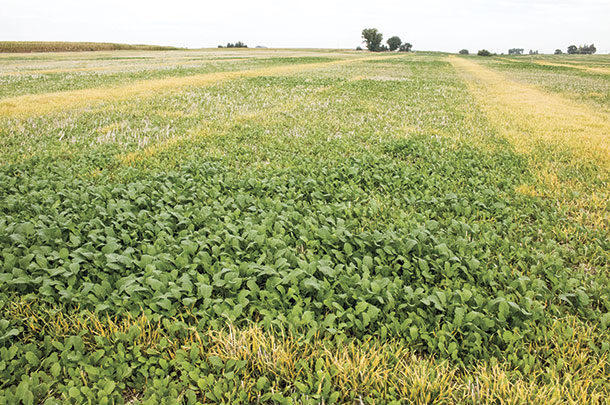Many varieties of brassicas exist; however, forage varieties have been bred to mature quickly and produce greater aboveground yields than their vegetable-crop counterparts. Forage varieties of rapeseed (rape), radish, turnip, swede, kale and hybrids have been developed over the last several decades and have recently become popular for use in pasture mixtures across the country.
Successful grazing management can be accomplished through strip or rotational grazing. Once forage has reached 8 to 14 inches, animals can begin to graze. This height can vary depending on species and variety used. If multiple grazings are desired, forage should not be grazed below a height of 6 to 8 inches.
The root-bulb of turnip, radish and swede can be grazed during the last grazing rotation of the season; however, consumption is largely dependent on individual animal curiosity and taste preferences.
We conducted a forage variety test to determine the forage quality and yield of three brassica varieties (Inspiration canola, Barisca rapeseed, and Appin turnip) and annual ryegrass (KB Supreme) grown during the fall grazing season in central Pennsylvania.
The data presented here represents two years of forage data (2015 and 2016). In both years, plots were planted during the last week of August into soil that was tilled and culti-packed prior to planting. All forages were planted to a 1/2-inch depth.
The brassicas were planted at 5 pounds pure live seed per acre, and the annual ryegrass was planted at 20 pounds pure live seed per acre. All forages were fertilized with 75 pounds of ammonium sulfate at the time of planting.
For all varieties tested, forage yield was greater in 2015 than 2016, likely due to greater fall rainfall during 2015. Forty-five days after planting, there was no difference in forage yield among all four varieties (Figure 1).

However, by day 60 (late October), the three brassica species had greater dry matter yields (680 to 692 pounds per acre) than ryegrass (222 pounds per acre), but there was no difference among the brassica varieties.
At the end of the season (day 74), the dry matter yields among the brassica varieties were similar (913 to 1324 pounds per acre) and were 102 to 193 percent greater than ryegrass (452 pounds per acre). All yields were lower than expected at day 60, when grazing would have been recommended.
All four forages had a very high crude protein content (greater than 26 percent; Figure 2), easily meeting or exceeding the crude protein requirements of any class of cattle.

Both neutral detergent fiber and acid detergent fiber were similar among the brassica varieties (17.3 and 13 percent, respectively). Both the neutral detergent fiber and acid detergent fiber of annual ryegrass were much greater (34.9 and 17.4 percent, respectively) than that observed in the brassicas.
All four forages had similar lignin concentrations (2 percent). When considering inclusion of brassicas in a cattle ration, animal management is crucial due to the high protein concentration and the lack of fiber in the diet causing bloat or other digestive disorders.
However, by supplementing 50 percent of the daily dry matter intake with a high-fiber forage (either feeding hay or planting brassicas as a mixture with other grasses), the majority of problems can be avoided. Net energy of gain was greatest in canola and rapeseed (0.49 Mcal per pound dry matter) than annual ryegrass or turnip (0.43 Mcal per pound dry matter).
Similarly, the total digestible nutrients were greatest in canola (71.4 percent), followed by rapeseed (69.8 percent) and annual ryegrass, and turnip had the least (66.5 and 66.2 percent, respectively). The diets of livestock with high production and growth rates (e.g., lactating dairy cattle or stockers) can be fed up to 50 percent brassicas.
In other classes of livestock (e.g., non-lactating dairy cattle or cow-calf pairs), brassicas should be treated as a supplemental feed due to the high energy content of the forage, and grazing should be limited to only a few hours per day.
The brassicas contained greater concentrations of both calcium (Ca) and phosphorus (P) than the annual ryegrass. Turnip had the greatest concentration of both minerals (2.2 percent Ca and 0.36 percent P), canola and rapeseed had similar concentrations (2.09 percent Ca and 0.32 percent P), and annual ryegrass contained lower concentrations of both minerals (0.67 percent Ca and 0.30 percent P).
All of the brassicas contained the same amount of magnesium (Mg) at 0.31 percent and sulfur (S) at 2.88 percent and were greater than annual ryegrass, which only contained 0.24 percent Mg and 0.5 percent S. Both turnip and annual ryegrass had greater amounts of potassium (4.05 percent) than either rapeseed (3.77 percent) or canola (3.37 percent). Micromineral concentrations were similar across all forage varieties (zinc, 32 ppm; copper, 5.5 ppm; manganese, 117 ppm; molybdenum, 1.0 ppm).
Brassicas produce a family of sulfur-rich compounds called glucosinolates. Due to the unique flavor profile in the brassicas resulting from the glucosinolates, some animals have been found to be less thrifty. This is largely due to an aversion to the plants and the resulting decrease in dry matter intake.
Additionally, these compounds can decrease uptake of copper and iodine, resulting in mineral deficiencies and in severe cases cause goiter and thyroid disorders. A trace mineral that includes copper and iodine should be fed to livestock to prevent possible deficiencies. Small ruminants tend to be more susceptible to these mineral deficiencies than cattle.
The copper requirement of sheep is lower than that of other ruminants, thus copper supplementation of sheep should be done with caution, especially if co-grazing multiple species.
Lastly, there is anecdotal information that suggests brassicas can cause an off flavor in meat and milk products of animals grazing them in large amounts. However, the little research available suggests this may not always be the case.
In either case, this can be avoided by implementing a withdrawal period prior to slaughter or milking. Brassicas can be a useful tool for extending the grazing season. However, to have the maximum benefit, the forage and grazing management must be carefully considered. ![]()
PHOTO: Brassicas can boost soil properties, but what about the animals that graze them? This author shares research about their nutritional value and grazing management strategies. Photo by Lynn Jaynes.
Kathy J. Soder, Ph.D. is also with the Pasture Systems and Watershed Management Research Unit, USDA-Agricultural Research Service.

-
S. Leanne Dillard
- Pasture Systems and Watershed Management Research Unit
- USDA-Agricultural Research Service
- Email S. Leanne Dillard











